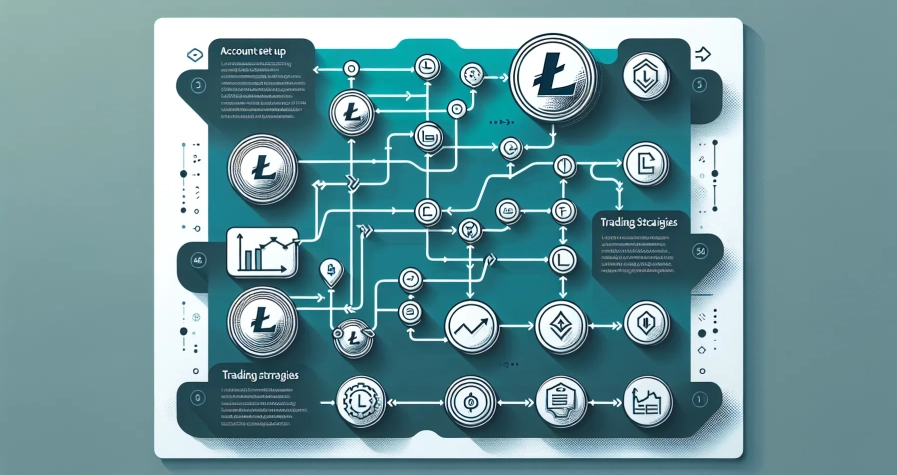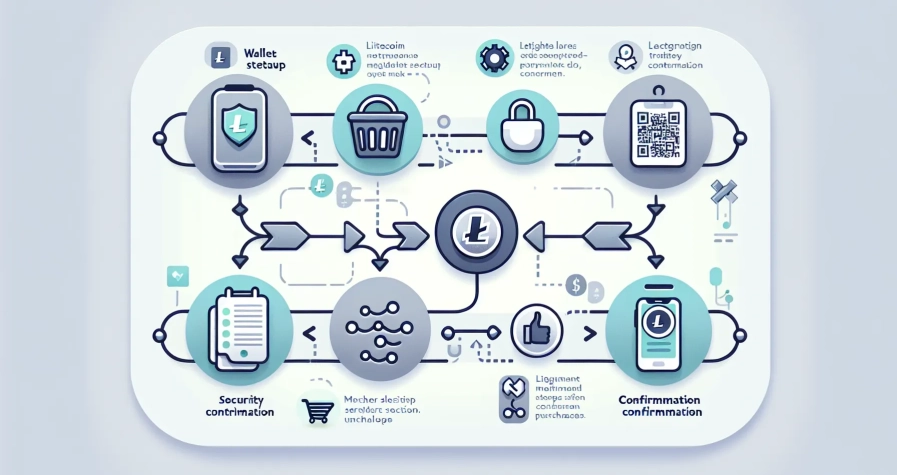Litecoin has carved out a solid place in the cryptocurrency ecosystem, attracting investors and enthusiasts who appreciate its faster transaction speeds and lower fees compared to Bitcoin. But for anyone new to crypto,or even seasoned traders exploring new payment options,figuring out how to buy Litecoin can feel like navigating a maze. Should someone use PayPal for convenience? Go with a credit card for instant access? Or stick with a bank transfer to save on fees?
The payment method matters more than most people realise. It affects everything from how quickly Litecoin lands in a wallet to how much gets eaten up in transaction costs. Some methods offer buyer protection and near-instant delivery, while others take a few days but reward patience with lower fees. Regional availability, verification steps, and even the platform’s policies can shift the experience dramatically.
This guide walks through the essential steps and considerations for buying Litecoin using PayPal, credit card, or bank transfer. It breaks down the pros and cons of each method, highlights trusted platforms, and covers the security measures that matter,so buyers can confidently choose the option that fits their needs and budget.
Key Takeaways
- Choosing the right payment method to buy Litecoin affects transaction speed, fees, and security, with PayPal and credit cards offering instant access at higher costs while bank transfers save money but take longer.
- PayPal enables buyers to purchase Litecoin instantly with strong buyer protection, though fees typically range from 3% to 5% and regional restrictions may apply.
- Credit card purchases deliver Litecoin within minutes but come with high fees and potential bank blocks, as some issuers treat crypto purchases as cash advances.
- Bank transfers via ACH are the most cost-effective way to buy Litecoin for larger amounts, with minimal fees but processing times of one to three business days.
- Selecting a reputable platform with proper licensing, KYC verification, and strong security protocols is essential for safely purchasing Litecoin.
- Storing Litecoin in a private hardware wallet instead of leaving it on an exchange provides maximum security and full control over your assets.
Understanding Litecoin and Why Payment Method Matters

Litecoin (LTC) isn’t just another cryptocurrency riding Bitcoin’s coattails. Created by Charlie Lee in 2011, it was designed to address some of Bitcoin’s limitations,specifically around speed and cost. Litecoin processes transactions in roughly 2.5 minutes compared to Bitcoin’s 10 minutes, and its network fees tend to stay consistently low. That’s made it popular not just as a speculative asset, but as a practical tool for transferring value quickly and affordably.
But here’s the thing: the method someone chooses to buy Litecoin can shape the entire experience. PayPal, credit cards, and bank transfers each come with their own set of trade-offs.
Speed is often the first consideration. PayPal and credit cards typically offer instant or near-instant transactions, which means Litecoin can hit a wallet within minutes. Bank transfers, on the other hand, usually take one to three business days to clear,slower, but often cheaper.
Fees vary wildly. Instant payment methods like PayPal and credit cards tend to charge higher transaction fees, sometimes ranging from 3% to 5% or more. Bank transfers,especially ACH (Automated Clearing House) transfers in the U.S.,usually come with much lower fees, though wire transfers can add extra costs depending on the bank.
Security and buyer protection also differ. PayPal and credit cards generally offer stronger recourse if something goes wrong,chargebacks, dispute resolution, fraud protection. Bank transfers, while secure, don’t always offer the same level of buyer protection once funds leave an account.
Finally, regional availability and verification requirements can limit options. Some platforms don’t support PayPal in certain countries, and credit card transactions may be blocked by banks wary of cryptocurrency purchases. Bank transfers are widely accepted but often require additional identity verification steps.
Choosing the right payment method isn’t just about convenience,it’s about balancing cost, speed, and security in a way that aligns with personal priorities and circumstances.
Choosing the Right Platform to Buy Litecoin

Not all crypto platforms are created equal. Some shine with user-friendly interfaces and instant transactions, while others stumble on hidden fees or lackluster customer support. When buying Litecoin, the platform choice can make or break the experience.
Leading platforms for purchasing Litecoin include Coinbase, Paybis, Swapped.com, and BitPay. Each has its strengths. Coinbase is well-known, heavily regulated, and offers a polished user experience,ideal for beginners. Paybis supports a wide range of payment methods including PayPal, and is praised for quick transactions. Swapped.com markets itself as a no-frills, fast exchange with competitive rates. BitPay, originally famous for payment processing, also allows users to buy crypto directly with credit cards or bank transfers.
But reputation and regulation should top the checklist. A platform might look sleek and offer low fees, but if it lacks proper licensing or has a history of security breaches, it’s not worth the risk.
Security and Reputation
Security isn’t optional,it’s foundational. Any platform worth using should require KYC (Know Your Customer) verification. Yes, the extra identity checks can feel tedious, but they’re a sign the platform takes compliance and fraud prevention seriously. KYC also helps protect users by reducing the likelihood of scams and illicit activity on the platform.
Encryption and secure transaction protocols are non-negotiables. Look for platforms that use SSL encryption for data transmission and store the majority of user funds in cold wallets (offline storage) rather than hot wallets vulnerable to hacking.
Reputation can be gauged through user reviews, regulatory standing, and transparency. Platforms that have been around for years, hold licenses from financial authorities (like FinCEN in the U.S. or FCA in the U.K.), and openly publish security practices tend to be safer bconversestigationsts. Check for a track record of responsive customer support,problems happen, and a platform that ghosts users during disputes is a red flag.
Fees and Processing Times
Fees and speed are the yin and yang of payment methods. Instant gratification usually costs more.
PayPal and credit cards are the express lanes. Transactions complete almost immediately, and Litecoin often arrives in minutes. But convenience has a price,fees typically range from 3% to over 5%, and some platforms add extra charges on top of that. Credit card companies may also treat crypto purchases as cash advances, tacking on additional interest.
Bank transfers move at a more leisurely pace. ACH transfers in the U.S. generally take one to three business days, while international wire transfers can take even longer. But, fees are significantly lower,sometimes under 1%,and larger purchases become more economical. Wire transfers may incur fees from both the sender’s and receiver’s banks, so it’s worth checking beforehand.
Here’s a quick breakdown:
| Payment Method | Speed | Fees | Security/Protection |
|---|---|---|---|
| PayPal | Instant | High (3–5%+) | High (buyer recourse) |
| Credit Card | Instant | High (3–5%+) | High |
| Bank Transfer | 1–3 business days | Low–Medium | High |
The right choice depends on urgency and budget. If someone needs Litecoin now and doesn’t mind paying extra, PayPal or credit card makes sense. If they’re buying a larger amount and can wait, a bank transfer is likely the smarter financial move.
How to Buy Litecoin with PayPal
PayPal has become a surprisingly crypto-friendly payment option in recent years, and several platforms now accept it for buying Litecoin. The process is straightforward, though it does involve a few important steps.
Step-by-Step Purchase Process
First, the buyer needs to register and verify an account on a platform that supports PayPal,options like Paybis and Coinbase are popular choices. Registration typically requires an email address, phone number, and identity verification (KYC). Expect to upload a government-issued ID and possibly a selfie for identity confirmation. This step can take anywhere from a few minutes to a couple of hours, depending on the platform’s verification backlog.
Next, fund the PayPal account if it’s not already loaded. This might seem obvious, but it’s worth double-checking the balance before initiating a purchase,some platforms won’t allow partial payments or split funding.
Once the account is set up and funded, the buyer selects Litecoin from the list of available cryptocurrencies, specifies the amount (either in fiat currency or LTC), and chooses PayPal as the payment method at checkout. The platform will display a summary of the transaction, including fees and the final amount of Litecoin to be received.
The next critical step is entering the Litecoin wallet address. This is where the purchased LTC will be sent. Buyers should have a wallet ready beforehand,whether it’s a software wallet, hardware wallet, or even a wallet address from another exchange. Double-checking the address is essential: crypto transactions are irreversible, and sending funds to the wrong address means they’re gone for good.
After confirming all details, the buyer completes the purchase. Litecoin is typically delivered instantly or within minutes once the PayPal transaction processes. Some platforms may hold the first transaction for additional review, but repeat purchases usually go through faster.
Advantages and Limitations of Using PayPal
PayPal’s biggest draw is speed. Transactions are instant, and the whole process,from login to receiving Litecoin,can happen in under 10 minutes. That’s appealing for anyone trying to catch a favorable price or simply wanting to avoid the wait.
Convenience is another plus. Most people already have PayPal accounts, and linking them to a crypto platform is usually seamless. There’s no need to enter bank account details or credit card numbers repeatedly.
Buyer protection is a major advantage. PayPal offers dispute resolution and fraud protection, which adds a layer of security not always present with other payment methods. If something goes wrong,say, Litecoin never arrives,there’s a mechanism to challenge the transaction.
But PayPal isn’t perfect. Higher fees are the most obvious downside. Platforms often charge a premium for PayPal transactions, and PayPal itself may take a cut depending on how funds were added to the account.
There are also restrictions. Not all countries support PayPal for crypto purchases, and some platforms impose maximum purchase limits,sometimes as low as a few hundred dollars per transaction. Frequent buyers might hit these caps quickly.
Finally, some sellers and platforms remain wary of PayPal due to the risk of chargebacks. While this protects buyers, it can make certain platforms hesitant to offer PayPal, or they may require extra verification steps to mitigate risk.
How to Buy Litecoin with a Credit Card
Credit cards are the go-to for anyone who values speed and simplicity. They’re widely accepted on crypto platforms, and the process from purchase to delivery is usually lightning-fast.
Completing Your Credit Card Purchase
Buying Litecoin with a credit card follows a similar flow to PayPal, but with a few twists. Platforms like Swapped.com, Coinbase, and BitPay support credit card payments and make the process fairly intuitive.
After creating and verifying an account, the buyer selects Litecoin and specifies the amount in their local fiat currency. The platform then prompts them to choose a payment method,selecting credit card brings up a form to enter card details (number, expiration date, CVV, billing address).
Some platforms use third-party payment processors like Simplex or MoonPay to handle credit card transactions. These processors add an extra layer of security but may also introduce additional fees or verification steps. It’s common to see a small authorization charge (like $1) temporarily appear on the card to verify it’s active.
Once payment details are entered, the buyer is asked to provide their Litecoin wallet address,the destination for the purchased LTC. As with PayPal, accuracy here is critical. A single wrong character can send funds into the void.
After reviewing the transaction summary,amount, fees, exchange rate,the buyer confirms the purchase. Litecoin is typically delivered within minutes, though first-time buyers might experience a short delay for additional security checks.
Pros and Cons of Credit Card Purchases
The primary advantage is speed. Credit card transactions are processed almost instantly, and Litecoin can arrive in a wallet in as little as five minutes. For someone trying to capitalize on a price dip or needing crypto urgently, this immediacy is invaluable.
Convenience is another win. Most people already have a credit card, and there’s no need to link a bank account or wait for funds to transfer. It’s a one-step process: enter card details, confirm, done.
Credit cards also offer fraud protection and dispute mechanisms. If something goes wrong,unauthorized charges, Litecoin never delivered,buyers can dispute the transaction through their card issuer.
But there are clear downsides. Fees are high,often in the 3% to 5% range, and some platforms charge even more. Payment processors add their own fees on top of the platform’s charges, which can compound quickly.
Another issue is that some banks block crypto-related transactions. They view crypto purchases as high-risk, and card issuers may decline the transaction outright or flag it as suspicious, requiring a phone call to authorize. Even worse, some banks treat crypto purchases as cash advances, which come with higher interest rates and no grace period,meaning interest starts accruing immediately.
There’s also the chargeback risk. While this protects buyers, it creates friction for platforms. Some exchanges limit credit card purchases or require extensive verification to prevent fraud, which can slow down the process.
For small, urgent purchases, credit cards make sense. But for larger amounts or regular buying, the fees add up quickly, and alternative payment methods become more cost-effective.
How to Buy Litecoin with Bank Transfer
Bank transfers are the tortoise in the race,they’re slower, but they often win when it comes to cost-efficiency and accommodating larger purchases.
ACH and Wire Transfer Options
There are two main types of bank transfers: ACH (Automated Clearing House) and wire transfers. Both move money from a bank account to a crypto platform, but they differ in speed and cost.
ACH transfers are common in the United States and are typically the cheapest option. They’re processed through a network that batches transactions, which is why they take one to three business days to clear. Fees are minimal,sometimes free, sometimes under 1%,and platforms like Coinbase and BitPay support them.
Wire transfers are faster (often same-day or next-day) but more expensive. Banks usually charge a fee,ranging from $15 to $50 depending on whether it’s domestic or international,and the receiving platform may add its own fee. Wire transfers make sense for urgent, large purchases where a day or two matters, but for most buyers, ACH is the better deal.
To initiate a bank transfer, the buyer first needs to link their bank account to the chosen platform. This usually involves entering account and routing numbers, then verifying the link through micro-deposits (small test amounts sent to the bank account that the buyer confirms) or instant verification through services like Plaid.
Once the bank is linked and verified, the buyer selects Litecoin, specifies the amount, and chooses bank transfer as the payment method. The platform initiates the transfer, pulling funds directly from the bank account.
After the funds clear,typically one to three business days for ACH, or sooner for wire transfers,the buyer receives their Litecoin. Some platforms release LTC immediately but restrict withdrawals until the bank transfer fully clears, which is a security measure against payment reversals.
Benefits and Drawbacks of Bank Transfers
The standout benefit is lower fees. ACH transfers often cost a fraction of what PayPal or credit cards charge, making them ideal for larger purchases where even a 1% fee difference can save significant money.
Bank transfers also support higher transaction limits. While PayPal and credit cards might cap purchases at a few thousand dollars, bank transfers can accommodate tens or even hundreds of thousands, depending on the platform and user verification level.
Direct funding from a bank account also offers peace of mind,there’s no intermediary like PayPal or a credit card company involved, and the transaction is straightforward.
The main drawback is speed,or lack thereof. Waiting one to three days for Litecoin to arrive can be frustrating, especially if the price moves unfavorably during that window. Unlike instant payment methods, bank transfers don’t allow buyers to lock in a price at the moment of purchase: the exchange rate is usually set when the funds clear.
There’s also the matter of additional verification. Linking a bank account can take time, and some platforms require extra identity checks for large transfers to comply with anti-money laundering (AML) regulations.
For patient buyers making substantial purchases, bank transfers are hard to beat. They’re cost-effective, secure, and capable of handling large amounts,just don’t expect instant gratification.
Storing Your Litecoin Safely After Purchase
Buying Litecoin is only half the equation. How it’s stored afterward can determine whether it remains safe or becomes an easy target for hackers.
The default option is leaving Litecoin in the exchange wallet where it was purchased. Platforms like Coinbase or Paybis provide wallets automatically, and for small amounts or short-term holdings, this might be fine. But exchanges are centralized and can be hacked, shut down, or frozen due to regulatory issues. History is littered with examples,Mt. Gox, Quadriga, and others,where users lost funds because they trusted an exchange to hold their crypto long-term.
The safer approach is transferring Litecoin to a private wallet,one where the owner controls the private keys. There are two main types: software wallets and hardware wallets.
Software wallets (also called hot wallets) are apps or programs installed on a computer or smartphone. Examples include Exodus, Electrum-LTC, and Trust Wallet. They’re convenient, easy to use, and free, but because they’re connected to the internet, they’re more vulnerable to malware or hacking.
Hardware wallets (cold wallets) are physical devices,like Ledger or Trezor,that store private keys offline. They’re the gold standard for security. Even if a computer is compromised, the hardware wallet keeps the keys safe. The downside is cost (usually $50–$200) and a steeper learning curve for beginners.
Whichever wallet is chosen, it needs to be compatible with Litecoin. Not all wallets support every cryptocurrency, so double-checking before transferring funds is essential.
Enabling two-factor authentication (2FA) adds another layer of protection. Most wallets and exchanges support 2FA through apps like Google Authenticator or Authy, requiring a code plus to a password for access.
Finally, back up the wallet. Whether it’s writing down a recovery phrase (a series of 12 or 24 words) or securely storing wallet files, having a backup ensures that Litecoin isn’t lost if a device fails or gets lost. Keep backups offline and in multiple secure locations,never stored digitally where they could be hacked.
Leaving Litecoin on an exchange might be convenient, but it’s essentially trusting someone else to safeguard assets. For anyone serious about holding LTC, moving it to a private wallet is the smarter, safer choice.
Conclusion
Buying Litecoin with PayPal, a credit card, or bank transfer isn’t complicated,but it does require some thought. Each payment method brings its own mix of speed, cost, and convenience, and the right choice depends on individual priorities and circumstances.
PayPal and credit cards win on speed and ease, delivering Litecoin almost instantly,but they cost more in fees and come with occasional restrictions. Bank transfers take longer and require patience, but they’re the most cost-effective option, especially for larger purchases. Choosing a reputable, secure platform is just as important as the payment method itself: factors like regulation, encryption, and customer support can make or break the experience.
And once the Litecoin is purchased, the journey isn’t over. Storing it securely in a private wallet,ideally a hardware wallet,protects against exchange hacks and ensures full control over the asset. Enabling 2FA and backing up wallet recovery phrases are simple steps that can prevent costly losses.
Litecoin’s strengths,fast transactions, low fees, and a solid track record,make it an appealing addition to any crypto portfolio. With the right platform and payment method, buying LTC can be smooth, secure, and tailored to fit anyone’s needs. Whether someone’s making their first crypto purchase or adding to an existing stash, understanding these options empowers smarter, more confident decisions.
Frequently Asked Questions
What is the fastest way to buy Litecoin?
The fastest methods are PayPal and credit cards, which process transactions almost instantly. Litecoin typically arrives in your wallet within minutes, making these ideal for buyers who need immediate access or want to capitalize on favorable prices.
How much do fees typically cost when buying Litecoin with PayPal or credit card?
PayPal and credit card purchases usually charge fees ranging from 3% to 5% or higher. These instant payment methods come with convenience but cost significantly more than bank transfers, which often have fees under 1%.
Can I buy Litecoin with a bank transfer, and how long does it take?
Yes, bank transfers are widely supported for buying Litecoin. ACH transfers typically take one to three business days to clear, while wire transfers can process same-day or next-day but usually come with higher fees.
Is it safe to leave my Litecoin on an exchange after purchasing?
While convenient for small amounts or short-term holdings, leaving Litecoin on an exchange carries risks like hacking or platform shutdowns. For better security, transfer your LTC to a private wallet where you control the keys, preferably a hardware wallet.
Why is Litecoin considered faster than Bitcoin?
Litecoin processes transactions in approximately 2.5 minutes compared to Bitcoin’s 10 minutes. Created by Charlie Lee in 2011, it was specifically designed to address Bitcoin’s speed limitations while maintaining lower network fees for users.
Do all crypto platforms accept PayPal for Litecoin purchases?
No, not all platforms support PayPal, and availability varies by country. Platforms like Coinbase and Paybis accept PayPal, but some exchanges avoid it due to chargeback risks or may impose lower purchase limits for PayPal transactions.








